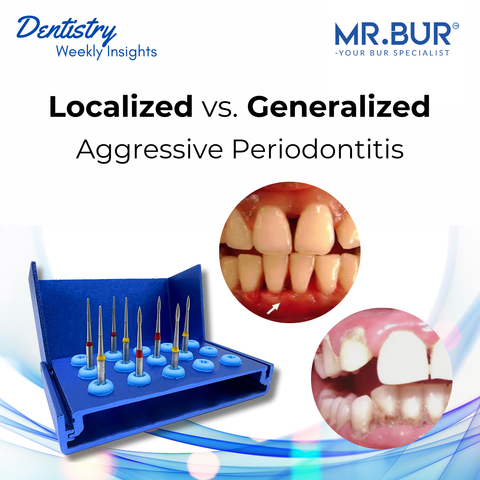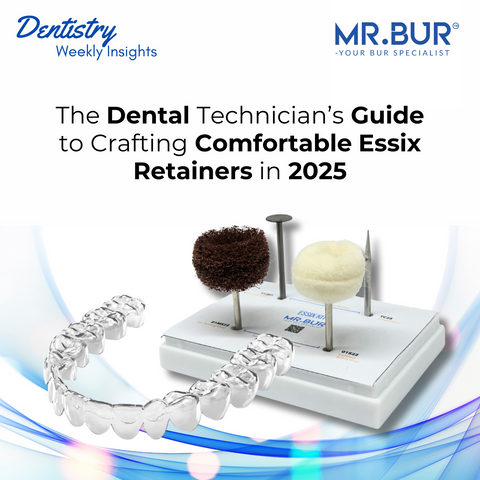Smoking is a well-established risk factor for periodontal diseases, significantly contributing to their onset, progression, and treatment challenges. For dental professionals, recognizing the link between smoking and specific gum diseases is critical for accurate diagnosis and effective management. This article outlines four gum diseases associated with smoking, their clinical presentations, and evidence-based treatment approaches, incorporating advanced tools like the Mr. Bur Gingivectomy Bur Kit for optimal outcomes.
1. Gingivitis
Gingivitis, characterized by inflamed, erythematous, and bleeding gums, is often exacerbated by smoking. Smokers may present with less overt bleeding due to nicotine-induced vasoconstriction, masking the severity of inflammation. Plaque and calculus accumulation, combined with smoking’s suppression of immune responses, accelerate gingival tissue damage.
Treatment
-
Non-Surgical: Initiate scaling and root planing (SRP) to remove plaque and calculus. Recommend smoking cessation programs, as continued tobacco use hinders resolution.
Recommend Kit: Mr. Bur Surgical Root Planing Kit
-
Surgical (if needed): In cases of persistent gingival enlargement, gingivectomy may be indicated. Using the Mr. Bur Gingivectomy Bur Kit, clinicians can achieve precise tissue excision, ensuring clean margins and minimal trauma to surrounding tissues.
-
Adjunctive Therapy: Prescribe antimicrobial rinses (e.g., chlorhexidine) and reinforce oral hygiene education to reduce bacterial load.
2. Chronic Periodontitis
Chronic periodontitis in smokers presents with deeper periodontal pockets, significant attachment loss, bone resorption, and tooth mobility. Smoking accelerates disease progression by impairing fibroblast function and reducing oxygen supply to periodontal tissues, leading to more severe radiographic bone loss compared to non-smokers.
Treatment
-
Non-Surgical: Perform thorough SRP, supplemented by local or systemic antibiotics (e.g., doxycycline) to manage bacterial infection.
-
Surgical: For advanced cases, flap surgery or gingivectomy may be required to access deep pockets or reshape gingival contours.
Check out: Degranulation in Flap Surgery and The Crucial Steps for Successful Periodontal Treatment
Recommend Kit: Mr. Bur Degranulation Kit
-
Maintenance: Implement a strict periodontal maintenance schedule and integrate smoking cessation counseling, as smoking significantly increases recurrence risk.
3. Aggressive Periodontitis
Aggressive periodontitis, though less common, is notably severe in smokers, particularly younger patients. Rapid attachment loss, deep pockets, and localized or generalized bone destruction are hallmarks. Smoking exacerbates the disease by altering neutrophil function and increasing bacterial virulence.
Treatment
-
Non-Surgical: Aggressive SRP combined with systemic antibiotics (e.g., amoxicillin and metronidazole) is essential to target aggressive pathogens.
-
Surgical: Gingivectomy or open flap debridement may be necessary for severely affected sites. The Mr. Bur Gingivectomy Bur Kit’s precision burs ensure efficient tissue sculpting, critical for managing complex cases with irregular gingival architecture.
-
Long-Term Management: Emphasize smoking cessation and genetic counseling, as aggressive periodontitis may have a familial component. Regular monitoring is crucial to prevent relapse.
4. Necrotizing Periodontal Diseases
Necrotizing ulcerative gingivitis (NUG) and necrotizing ulcerative periodontitis (NUP) are strongly associated with smoking. Patients present with painful, ulcerated interdental papillae, a characteristic “punched-out” appearance, and fetid breath. Smoking, often combined with stress or immunosuppression, precipitates these acute conditions.
Treatment
-
Non-Surgical: Immediate debridement under local anesthesia is critical, followed by chlorhexidine irrigation. Prescribe metronidazole or amoxicillin for 7–10 days to address anaerobic infections.
-
Surgical: In cases of significant tissue necrosis, gingivectomy may be required to remove devitalized tissue. The Mr. Bur Gingivectomy Bur Kit’s sharp, durable burs allow for meticulous excision, preserving healthy tissue and promoting rapid healing.
-
Patient Education: Stress smoking cessation and nutritional counseling, as deficiencies (e.g., vitamin C) often exacerbate necrotizing diseases.
Strategies for Optimal Outcomes
-
Smoking Cessation: Integrate cessation programs into treatment plans, as continued smoking impairs healing and increases recurrence risk. Refer patients to resources like nicotine replacement therapy or counseling.
-
Precision Tools: Leverage advanced instruments like the Mr. Bur Gingivectomy Bur Kit to enhance surgical precision, reduce operative time, and improve patient comfort during gingivectomy procedures.
-
Interdisciplinary Approach: Collaborate with periodontists, oral surgeons, and medical professionals to address systemic factors (e.g., diabetes, stress) that compound smoking-related gum diseases.
-
Patient Compliance: Reinforce oral hygiene protocols and schedule frequent follow-ups to monitor disease stability and prevent progression.
Smoking significantly contributes to gingivitis, chronic periodontitis, aggressive periodontitis, and necrotizing periodontal diseases, each presenting unique diagnostic and therapeutic challenges. By recognizing these conditions and employing targeted treatments, ranging from non-surgical debridement to precise gingivectomy with tools like the Mr. Bur Gingivectomy Bur Kit, dental professionals can mitigate the destructive effects of smoking on periodontal health. Prioritizing smoking cessation and comprehensive patient care is paramount for long-term success.
At MR.BUR UNITED KINGDOM, we pride ourselves on exceeding expectations and continually improving to meet the evolving needs of our customers.
Diamond Burs, Carbide Burs, Surgical & Lab Use Burs, Endodontic burs, IPR Kit, Crown Cutting Kit, Gingivectomy Kit, Root Planning Kit, Orthodontic Kit, Composite Polishers, High Speed Burs, Low Speed Burs


